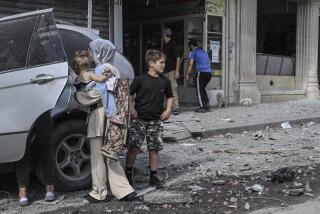The U.S. in Iraq: An audit of the pain
- Share via
Tuesday, the U.S. “stood down” in Iraq, finalizing the pullout of 140,000 troops from Iraqi cities and towns -- the first step on the long path home. After more than six years, most Americans are war-weary, even though a smaller percentage of us have been involved in the actual fighting than in any major conflict in U.S. history. We have relegated the car and suicide bombings to the inside pages of newspapers, accepting at face value that the “surge” has calmed things down enough so we can finally leave the whole sorry Iraq adventure behind us.
But not so fast. The conflict that began in 2003 is far from over for us, and the next chapter -- confronting a Taliban that reasserted itself in Afghanistan while the U.S. was sidetracked in Iraq -- will be expensive and bloody. The death toll for U.S. troops in Iraq and Afghanistan reached 5,000 in June. An additional 80,000 Americans have been wounded or injured since the war in Iraq began. More than 300,000 of our troops have required medical treatment, and Army statistics show that more than 17% of our returning soldiers suffer from post-traumatic stress disorder.
Meanwhile, in Iraq, even though most of the population has long told pollsters they can’t wait for U.S. forces to leave, U.S. officials have said we are likely to station 50,000 troops at military bases in the country for the foreseeable future. This is because the situation in Iraq is highly precarious. The country ranks high on lists of the most dangerous places on Earth, with a continual stream of suicide bombings and murders targeting political and religious leaders as well as civilians. According to the Brookings Institution’s Iraq Index, 2 million people -- largely from the middle class by most accounts -- fled Iraq during the war, but only a handful have returned. (The vast majority of Iraq’s doctors, lawyers and other professionals are now living abroad, and many are seeking asylum.) An additional 2.7 million “internal” refugees -- 10% of the population -- abandoned their homes, and most are too frightened to go back. The struggle for power among Kurds, Shiites and Sunnis is still in flux, with battles looming over oil and land.
Moreover, the U.S. has barely begun to face the enormous financial bill for the war. By our accounting, the U.S. has already spent $1 trillion on operations and related defense spending, with more to come -- and it will cost perhaps $2 trillion more to repay the war debt, replenish military equipment and provide care and treatment for U.S. veterans back home. Many of the wounded will require indefinite care for brain and spinal injuries. Disability payments are ramping up and will grow higher for decades. The stress of extended, multiple tours to Iraq means that a whole generation of U.S. military men and women may now be suffering from long-term mental health issues. The suicide rate in the Army is at its highest level since record-keeping began.
This wartime spending has undoubtedly been a major contributor to our present economic collapse. The U.S. has waged an expensive war as if it required little or no economic sacrifice, funding the conflict by massive borrowing. As we’ve observed in the past, you can’t spend $3 trillion on a reckless foreign war and not feel the pain at home.
Burned by the difficulties in Iraq, our political leaders have no illusions about the length and difficulty of the challenge facing us in Afghanistan. But in other respects we seem set to repeat the same mistakes that we made in Iraq. The president has just signed yet another “emergency” supplemental appropriations measure ($80 billion) to fund continuing operations in Iraq and expansion into Afghanistan. This means that for the 30th time since 2001, war spending has been rushed through the budget process without serious scrutiny.
The U.S. has 240,000 contractors working in the two war theaters -- but the Pentagon’s oversight of independent contractors remains lax. The Army Criminal Investigation Command -- which just a few weeks ago brought fraud charges against a contractor responsible for supplying our troops with bulletproof vests -- is woefully understaffed, with fewer than 100 people to investigate billions of dollars in alleged war profiteering.
Obstacles continue to beset returning veterans too. Despite an increase in the Department of Veterans Affairs budget, the backlog of disability claims has reached its highest level ever, and the budget for helping returning veterans reintegrate into civilian life is less than we spend in a single day of combat operations.
Early this year, President Obama committed 20,000 troops to a “surge” in Afghanistan. That, combined with a large, ongoing presence in Iraq and continued reliance on private contractors for virtually every aspect of military support, remains a recipe for staggering out-of-control expenditures -- now and in the future. Surely we can draw some lessons from the Iraq debacle and set aside money to care for our veterans, crack down on fraud and profiteering, and account for the true costs of the war in the budget so the American taxpayer can see what we are paying for.
More to Read
Sign up for Essential California
The most important California stories and recommendations in your inbox every morning.
You may occasionally receive promotional content from the Los Angeles Times.










